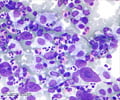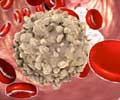Causes/Risk Factors
The causes of Acute Lymphoblastic Leukemia are not very clear. Researchers have indicated that ALL is caused by a combination of genetic, biologic, and environmental factors.
Few of the risk factors / causes indicated for ALL are-
a) Medical Conditions
Children with Down syndrome harbor a several-fold increased risk for developing acute leukemia (both ALL and AML). ALL is more common among the Down Syndrome patients. Outcome for Down syndrome children affected by ALL has generally been reported as poorer than that of non–Down syndrome children.
b) Genetic Factors
Certain other genetic conditions that have been implicated are:
- Neurofibromatosis
- Shwachman syndrome
- Bloom's syndrome
- Ataxia telangiectasia
- Myelodysplastic syndrome
- Myeloproliferative disorders
- A number of mutations have been associated with ALL. Translocations, or the rearrangement of genes between two chromosomes, have been associated with upto 65% of all leukemias.
- The most common mutation in ALL is t (12:21). Occurs in 20% of ALL patients
- Philadelphia (Ph) chromosome [t(9;22)] is observed in 5% children and in 20% adults with ALL
The Ikaros gene normally plays a role in regulating lymphoid differentiation. In ALL patients, it fuses with the BCL6 gene and results in a translocation, t(3;7)(q27;p12).
c) Environmental Factors
In children who are exposed to various hazardous substances and chemicals, the insult might have taken place early in life either as a fetus when they are in utero, or post-natally.
Approximately 75,000 synthetic chemicals have been introduced during the first half of the 21st century. It is important to study the role of these chemicals, including pesticides and herbicides, in causing leukemia. Broadly the environmental factors include:
- In utero or postnatal exposure to high-dose ionizing radiation, such as X-rays or gamma rays
- Radiotherapy for cancer treatment may lead to the development of leukemia in the future
- Viral infections, such as those of Human Thymic Leukemia Virus (HTLV-1,) has been suspected to trigger T-cell leukemia in humans
- Studies have reported a link between leukemia and increased exposure to electromagnetic radiation (EMR)
- High voltage power lines have also been linked with leukemia. This theory is refuted by many.













